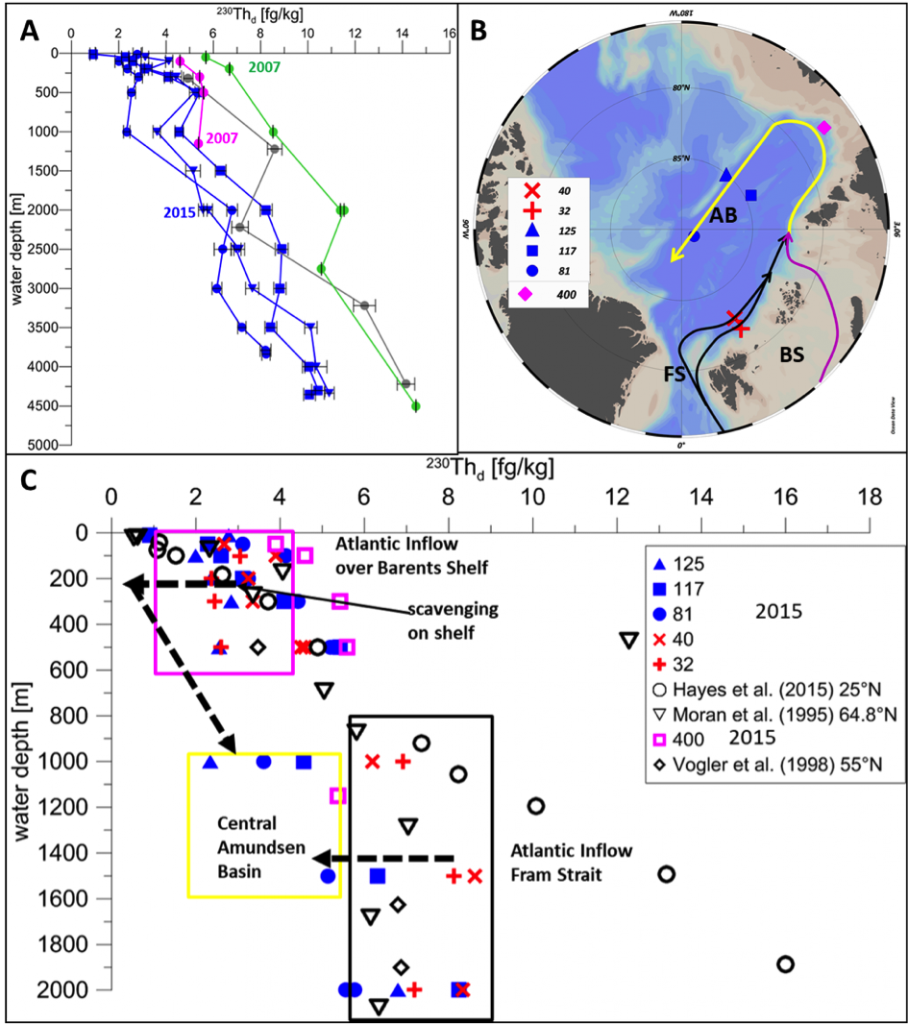Time series thorium-230 data reveal scavenging intensification over the last 15 years in the Arctic Ocean
Since 2007, thorium-230 (230Th) concentrations decreased significantly over the entire water column, particularly between 300 and 1,500 m in the Amundsen Basin, Arctic Ocean. As is often the case with 230Th, this decrease could reflect either ventilation of 230Th-depleted water or removal of this particle reactive tracer by scavenging intensification. Valk and co-workers (2020, see reference below) demonstrate that the later hypothesis is likely explaining 230Th-depletion in intermediate layers of the Amundsen basin. They also hypothesize that the scavenging intensification occurs at the “source” and during the transport of these waters, along the Siberian shelves.

(B) Atlantic Waters, entering the Arctic Ocean, flow through these areas and loose a significant part of their dissolved 230Th content by scavenging onto particles. As these waters progress on their way following the Arctic Ocean circulation (yellow arrow), the 230Th removal process continues. Station 400 from 2007 (pink profile in A and pink diamond in the map) showed already in 2007 low 230Th concentrations, comparable to 2015 in the central Amundsen Basin. The conclusion was that a change observed in the central AB in 2015 was already affecting areas upstream.
(C) This process is illustrated as the development of 230Th concentrations from the North Atlantic [3] over the Norwegian Seas [4, 5] and along the margins of the Eurasian Basin [6] towards the central Amundsen Basin. As the Barents Sea Inflow water sinks to greater depths it mixes with ambient waters and causes, together with the Fram Strait (FS) Inflow, a depletion of dissolved 230Th in the Amundsen Basin.
Reference:
1. Valk, O., Rutgers van der Loeff, M. M., Geibert, W., Gdaniec, S., Moran, S. B., Lepore, K., Edwards, RL., Lu, Y., Puigcorbé, V., Casacuberta, N., Paffrath, R., Smethie, W. Roy-Barman, M. (2020). Decrease in 230Th in the Amundsen Basin since 2007: far-field effect of increased scavenging on the shelf? Ocean Science, 16(1), 221–234. DOI: https://doi.org/10.5194/os-16-221-2020
2. Scholten, J.C., M.M. Rutgers van der Loeff, and A. Michel, Distribution of 230Th and 231Pa in the water column in relation to the ventilation of the deep Arctic basins. Deep-Sea Research II, 1995. 42: p. 1519-1531.
3. Hayes, C.T., et al., 230Th and 231Pa on GEOTRACES GA03, the U.S. GEOTRACES North Atlantic transect, and implications for modern and paleoceanographic chemical fluxes. Deep-Sea Research Part II: Topical Studies in Oceanography, 2015. 116: p. 29-41.
4. Vogler, S., et al., 230Th in the eastern North Atlantic: the importance of water mass ventilation in the balance of230Th. Earth and Planetary Science Letters, 1998. 156(1–2): p. 61-74.
5. Moran, S.B., et al., High precision 230Th and 232Th in the Norwegian Sea and Denmark by thermal ionization mass spectrometry. Geophysical Research Letters, 1995. 22(19): p. 2589-2592.
6. Gdaniec, S., et al., 231Pa and 230Th in the Arctic Ocean: Implications for boundary scavenging and 231Pa-230Th fractionation in the Eurasian Basin. Chemical Geology, 2020. 532: p. 119380.
